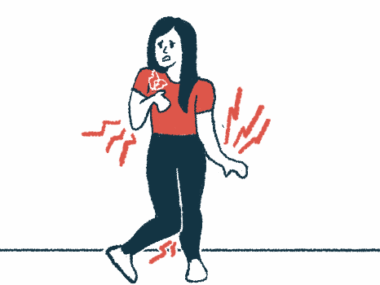Rare Case of Post-COVID-19 Vaccine NMOSD Reported; No Causal Link
Researchers note 16th reported case of disease onset, exacerbation after vaccination
Written by |

A 67-year-old man developed a rare case of neuromyelitis optica spectrum disorder (NMOSD) after his third dose of the COVID-19 vaccine, a study reports.
A review of published literature showed this case adds to 15 other reported cases of post-COVID-19 vaccination NMOSD onset, which appear to show similar clinical features to non-vaccine-related cases, the researchers noted.
The cases further support previous reports that suggest the vaccines may, in rare instances, promote or exacerbate autoimmune diseases, such as NMOSD, from their silent state.
While no cause-and-effect relationship has been established between the vaccination and NMOSD, “clinicians should be aware of possible post-vaccination autoimmune neurological disorders including NMOSD to help with earlier diagnosis and treatment to minimize long-term deficits,” the researchers wrote.
The study, “Aquaporin-4 IgG neuromyelitis optica spectrum disorder onset after Covid-19 vaccination: Systematic review,” was published in the Journal of Neuroimmunology.
In NMOSD, self-reactive antibodies are produced that attack proteins in cells that support the nervous system, impacting mainly the optic nerve, which sends visual information from the eyes to the brain, and the spinal cord.
While it’s still unclear what triggers the antibodies and for NMOSD to develop, certain environmental factors that prime the immune system are thought to contribute. Vaccinations have been proposed as a potential trigger of either disease onset or relapse because they can activate the immune system.
“As massive worldwide vaccination programs against COVID-19 occurred in response to the pandemic, multiple cases with potential post-vaccination neurological complications have been reported including NMOSD,” the researchers wrote.
Man’s symptoms occur after third vaccine dose
A team led by researchers at Mayo Clinic, Scottsdale described the case of a 67-year-old man without a history of autoimmune disorders who developed NMOSD after a COVID-19 vaccination.
Two weeks after receiving the third dose of an mRNA COVID-19 vaccine (sold by Pfizer-BioNTech and Moderna), the man developed pain in his left eye. This progressed over the next week to include a worsening headache with nausea, vomiting, and hiccups, “for which he presented to an outside emergency department and discharged without clear diagnosis,” the researchers wrote.
He then developed left-side weakness and numbness and was admitted to an outside facility, where MRI imaging of the spine showed signs of spinal cord inflammation. The man tested positive for antibodies against aquaporin-4 (AQP4), the most common type of NMOSD-causing antibody.
He was diagnosed with AQP4-NMOSD, treated with into-the-vein methylprednisolone, an immunosuppressive treatment, and plasma exchange. He was sent home after his symptoms began to diminish.
Plasma exchange involves removing and replacing a person’s plasma — the liquid portion of blood that contains water, salts, and proteins — which is used to remove the self-reactive antibodies in the case of NMOSD.
But the man’s symptoms got worse, affecting both his left-side strength and his vision in his left eye. Two weeks after being discharged, he went to the researchers’ clinic where inflammation in both his spinal cord and optic nerve was detected.
Despite initial treatment, he had severe neurological deficits and significant disability at the time of his discharge, up to 60 days after the onset of symptoms. He was started on Soliris (eculizumab), a NMOSD-approved therapy, to prevent additional attacks.
More cases of NMOSD onset after vaccine
To learn more about the possible link between COVID-19 vaccines and NMOSD, the researchers searched the existing literature to look for other cases, particularly cases of NMOSD positive for anti-AQP4 antibodies, the disease’s most definitive diagnostic gauge.
They identified 15 cases (11 women, four men) with onset after COVID-19 vaccination — 16 cases with their own report. Patients’ median age at symptom onset was 63 (range, 26–80), and they had received different types of COVID-19 vaccines.
A total of eight patients (50%) developed symptoms after a first dose, six (37.5%) after a second, and two (12.5%) after a third, with a median time to symptom onset of 8.5 days after vaccination (range, 1–42 days).
The fact that most patients developed NMOSD after the first dose raises “the possibility that vaccines may trigger overt clinical manifestations in patients with pre-existing or subclinical autoimmunity,” the researchers wrote.
Six patients (38%) had other types of self-reactive antibodies, one had pre-existing autoimmune disease that affects blood clotting, called immune thrombocytopenia, and one received a new diagnosis of Sjögren’s syndrome, an autoimmune condition that mainly affects the tears- and saliva-producing glands.
“Our review indicates that NMOSD cases post COVID-19 vaccination have similar natural history to non-vaccine-related cases and to those reported after other types of vaccinations,” the researchers wrote.
For the 14 cases with available follow-up data after being discharge from the hospital, the symptoms resolved or improved for 12 (85.7%).
One (7.1%) continued to have symptoms following two months of hospitalization for a second NMOSD attack after not being given maintenance treatment for an initial attack. Another (7.1%) died from respiratory failure during the NMOSD attack.
The study offers the largest number of NMOSD cases linked to COVID-19 vaccination yet reported.
However, “causal [cause-and-effect] relationships may continue to be difficult to establish given that NMOSD is a rare disease, and the unprecedented massive COVID-19 vaccination has so far been limited to a short period of time,” the researchers wrote. “Large epidemiological studies are needed to investigate correlations further.”






